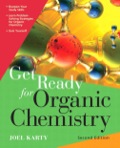
Concept explainers
(a)
Interpretation:
Using Appendixes C and D, synthetic step B shown in the synthesis scheme in Equation 13-10 is to be found. The table number and the entry number for reaction are to be identified.
Concept introduction:
The reactions that alter the carbon skeleton require carbon-carbon
(b)
Interpretation:
Using Appendixes C and D, synthetic step C shown in the synthesis scheme in Equation 13-10 is to be found. The table number and the entry number for reaction are to be identified.
Concept introduction:
Want to see the full answer?
Check out a sample textbook solution
Chapter 13 Solutions
EBK GET READY FOR ORGANIC CHEMISTRY
- Provide the missing curved arrow notation and second step for the below E1 mechanism. In the second box, only draw in a byproduct or reagent, such as Br" or CH3OH, if it reacts in that step. Be sure to include lone pair electrons and nonzero formal charges. See Periodic Table See H Provide the missing curved arrow notation for the E1 mechanism. O: I +arrow_forwardFor the following reaction scheme , please convert the starting material to the corresponding product. If the reaction is destined to fail, please write " no reaction " to the right, otherwise draw the appropriate product to the right of the arrow.arrow_forwardComplete the following reaction diagram by giving the reaction condition or the missing product. The reaction mechanism is not required.arrow_forward
- The starting compound was treated with different nucleophiles shown in the table. The reaction was carried out in ethanol (similar to CH3OH) at 25°C. This time the leaving group isn’t a single (halogen) atom; it's a group of atoms that leaves as a unit. (CH3);COC,H4NO2 + NaNu or HNu (CH3);CNu + brightly colored compound The byproduct has an intense yellow color, while the starting materials are colorless, so the appearance of a yellow color indicates the reaction is occurring. Reaction Nucleophile (Nu) Compound Relative reactivity Number Color change observed NaOCH3 Yellow after 0.52 sec 1 Very bright yellow immediately НОСНЗ 2 NaSCH3 Yellow after 0.52 sec 3 Faint bright yellow immediately HSCH3 4 1. Rank the relative reactivity of nucleophiles. The shortest time means fastest reaction, which gets number 1 reactivity. The longest time means slowest reaction, which gets the highest number. There may be some tied scores. 2. The name of the mechanism that best explains all four reactions…arrow_forwardThe following reaction, which is discussed in Chapter 8, is an example of a unimolecular nucleophilic substitution (Sn1) reaction. It consists of the four elementary steps shown here. For each step (i-iv), (a) identify all electron-rich sites and all electron-poor sites, (b) draw in the appropriate curved arrows to show the bond formation and bond breaking that occur, and (c) name the elementary step. (i) H-OCH3 OH + H-OCH3 H. H (ii) ©CH2 + H,O (iii) ©CH2 CH3 + HO-CH3 (iv) CH3 CH3 + H2O-CH, + НО—СНЗ foarrow_forwardSolve reactions in boxes 7 and 8 and show mechanism pleasearrow_forward
- Provide a mechanism for the intramolecular nucleophilic addition and elimination reaction shown here by providing the missing structures (including the final product) and curved arrows. The reaction resembles a Dieckmann condensation, except instead of two esters, the molecule contains an ester and a ketone. The ketone is more acidic and will be the nucleophile. Your structures should include all nonzero formal charges and lone pairs of electrons. When drawing the enolate place the negative charge on the carbon not the oxygen.arrow_forwardConsider the molecule given below. In theory, there are only two inequivalent hydrogens in this molecule that could be substituted by Br in a free radical bromination – circle them. Put an asterisk to mark the one most likely to be substituted first. However, there are 5 possible products from free radical bromination. Draw all the products and show using arrow formalism how the intermediate radicals leading to these products formedarrow_forwardThey are Sn1 and Sn2 reactions Answer step by step with explanation Please answer correct i will give you upvote.arrow_forward
- H₂C H H₁C Br NBS CH, CH₂ CC, hv **You may assume that Br-Br is formed by a side reaction that occurs (which we discussed in class). This is useful for one of the steps of the mechanism.arrow_forwardWould these be the correct mechanism arrows for this reaction?arrow_forwardDraw the reactant or major organic product for each of the reactions shown below.arrow_forward
 ChemistryChemistryISBN:9781305957404Author:Steven S. Zumdahl, Susan A. Zumdahl, Donald J. DeCostePublisher:Cengage Learning
ChemistryChemistryISBN:9781305957404Author:Steven S. Zumdahl, Susan A. Zumdahl, Donald J. DeCostePublisher:Cengage Learning ChemistryChemistryISBN:9781259911156Author:Raymond Chang Dr., Jason Overby ProfessorPublisher:McGraw-Hill Education
ChemistryChemistryISBN:9781259911156Author:Raymond Chang Dr., Jason Overby ProfessorPublisher:McGraw-Hill Education Principles of Instrumental AnalysisChemistryISBN:9781305577213Author:Douglas A. Skoog, F. James Holler, Stanley R. CrouchPublisher:Cengage Learning
Principles of Instrumental AnalysisChemistryISBN:9781305577213Author:Douglas A. Skoog, F. James Holler, Stanley R. CrouchPublisher:Cengage Learning Organic ChemistryChemistryISBN:9780078021558Author:Janice Gorzynski Smith Dr.Publisher:McGraw-Hill Education
Organic ChemistryChemistryISBN:9780078021558Author:Janice Gorzynski Smith Dr.Publisher:McGraw-Hill Education Chemistry: Principles and ReactionsChemistryISBN:9781305079373Author:William L. Masterton, Cecile N. HurleyPublisher:Cengage Learning
Chemistry: Principles and ReactionsChemistryISBN:9781305079373Author:William L. Masterton, Cecile N. HurleyPublisher:Cengage Learning Elementary Principles of Chemical Processes, Bind...ChemistryISBN:9781118431221Author:Richard M. Felder, Ronald W. Rousseau, Lisa G. BullardPublisher:WILEY
Elementary Principles of Chemical Processes, Bind...ChemistryISBN:9781118431221Author:Richard M. Felder, Ronald W. Rousseau, Lisa G. BullardPublisher:WILEY





